Oh, my.
B5’s third season is considered one of the best, and certainly some of the best eps in the series are in this season. As such, “Grey 17 Is Missing” is such a clunker, it’s infamous just for that.
Joe Straczynski has officially apologized for the ep — at least for the A-Plot (with one notable exception that I’ll mention below). The B-Plot is much more interesting, engaging, and noteworthy, and the greatest mystery about “Grey 17 Is Missing” is why the episode was named, and spent so much time on, the weakest half of the narrative.
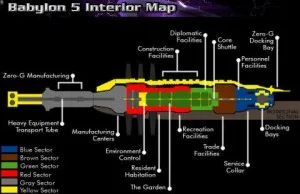
A note on the structure of B5: Humans do not possess (as the Minbari, Centauri, and many other races do) the secret of artificial gravity. Thus, their ship and stations rely on centrifugal force (spin) to simulate gravity. As the map (source) shows, there are different colored sectors for various purposes on the station.
Movement within the station on the lifts is three-dimensional. Because of the use of rotation for gravity “up” is towards the core, “down” is toward the hull — which means that “lower” levels will have higher “gravity,” more core-ward levels lower “gravity.” This distinction is generally ignored during the show except when there’s discussion of zero-G in the core shuttles, as in “The Fall of Night” when Sheridan initially falls very slowly because he’s starting from the core.

What’s unclear is that when you’re referring to a level — “Grey 17,” for example — are you dealing with (a) an actual toroidal level (that presumably stretches the length of the station, albeit with bulkheads and relabeling as different colors as you go fore or aft), or are you dealing with (b) a vertical slice of the station (multiple levels perpendicular to a particular spot along the core). B5’s writing goes both ways — you have the sense that a lift is going “up/down” (which would be the case for (a)) — but that implies that Grey 17 is really level 17 in the Grey section of the station, and connects with Red 17, Green 17, etc.). But the writing also gives the impression of (b), that as you go further back into the station you go deeper into Grey sectors — but that means that Grey 17 would be a slices of multiple levels from the core to the hull, which also doesn’t tie into how the sectors are presented.
In short, B5 tends to be written as though the station is a very tall building, but the rotational aspect of the place means that’s simply not true. Especially when you get to this episode …

A-Plot: It turns out there’s a “missing” Grey level . The schematics show 30 Grey levels, but taking the lift one by one gives you only 29. Garibaldi discovers, through a Series of Improbable Events, that there’s a level that’s off the charts — the elevators skip over it, and even the numbering scheme doesn’t mention it — you go from Grey 16 to Grey 17, and there’s a level in-between.
(How this was set up, how the level labels were posted in error, and why nobody ever noticed this is never, ever addressed in the show, except to handwave about how quickly the place was built. Yes, that’s dumb.)
It also turns out that this level is inhabited by a human apocalyptic cult, seeking purity of thought in understanding that the universe is seeking self-awareness (a previously mentioned Minbari concept), and then purity of body by being hunted down by a Zarg, “the most dangerous creature in the sector,” who appears to be an Alien/Predator Rubber Suit Guy, and one of the worst FX on the show ever.

JMS admits everything about this plotline is a train wreck of his own doing, but his’ one denial of blame is that the production meetings and the script all note clearly that the Zarg is never to be fully seen, only hinted at; the director. John Flinn, instead played contrary to past experience and fully lit the Rubber Suit Monster on more than one occasion — which, as it turns out, looked appalling like a Rubber Suit Monster.
The cult is run by Robert Englund (known better in genre films as Freddie Kruger), who spends endless periods of time pontificating on his theory of the universe. How he and the others ended up there, how they managed to hide the level (assuming they did), what they do when not listening to preaching or being eaten — is never really explained, either.

In the end, Garibaldi confronts the Zarg by using a combination of a steam (!) pipe and some bullets (!) that he coincidentally (and for reasons that even he can’t explain) was playing with at the beginning of the episode and just happened to put into his pants. And, faster than you can say “Hey, didn’t Kirk do this in a rather less unrealistic fashion in the Star Trek episode ‘Arena’?” the Zarg is dead (apparently one bullet is all it takes, ooh, scary), and Garibaldi eventually breaks out of Grey 17 and regales Sheridan with the tale.
It’s awful. It’s stupid, It’s one incredibly dumb concept, and story element, and writing technique, and FX shot after another. This is a 1.2 rated episode chunk that makes “TKO” look like Hamlet. The only thing it has going for it is watching Garibaldi get more and more frustrated, and that’s because that’s what every viewer is feeling.
As JMS puts it in the script book, “Half of this episode I love. The other half should be tied to a rock and dumped into the ocean, me with it.”
‘Nuff said.
The entirety of the A-Plot is included in the 18 incredibly long minutes below. Watch it, and despair:
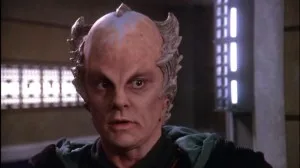
Enter Neroon, her old warrior caste nemesis. We saw him parading around with the body of Branmer in “Legacies,” and upsetting the balance of the Grey Council in “All Alone in the Night.” Now, with the Grey Council broken, he’s on B5 to keep Delenn from becoming Ranger One. Part of it is warrior caste tribalism — they were traditionally in charge of the Rangers (though the group had been disbanded until Delenn started it back up again). Part of it is … well, actually pretty rational analysis of the situation. Delenn comes off (in his eyes) as a mad priest who has overthrown the existing power structure (the Grey Council), and now is attempting a military take-over. “A religious zealot compelled by ambition to take political and military power? Always a bad idea.”
And, if you ignore the framing of Delenn obviously being a hero-protagonist, Neroon is absolutely right. Imagine a B5 episode where we learn that a high ranking member of the Minbari religious caste is building his own fleet, training his own spies and shock troops, and is convinced by prophecy that he knows the One True Path for Minbar and the galaxy. Oh, and he’s undergoing strange body modifications and consorting with aliens and fomenting rebellion in the government. That would make an obvious villain for at least an entire season. Why is Delenn (who has done some pretty tricksy political maneuvering, lying, and shaping of destinies across the earlier seasons) therefore automatically accepted by us as a hero who is correct and justified in what she does? Because that’s how the story is written, especially this season.
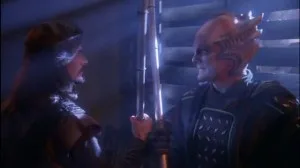
Whether petty or profound (or both) Neroon swears to her that he will stop her, no matter what. Which she interprets as a death threat, Minbari traditions aside, which she relays to Lennier, who (being deeply, passionately, “purely” in love with Delenn) twists her orders not to tell Sheridan anything about this by telling Marcus, instead. Marcus, of course, being a Ranger, a Romantic, and a Guy with a Death Wish, is more than happy to face down Neroon in a battle of Minbari staff fighting, a duel to the death … which Marcus, of course, inevitably, loses.
Except, of course, he wins, by demonstrating to Neroon how dedicated the human Rangers are to Delenn. Now, this could have made Neroon more determined to purify the Rangers by taking over and getting rid of the humans. Or it could have made him more paranoid about how Delenn is building up a Cult of Personality around herself. Instead, his self-righteousness and resentment “die,” which lets him spare Marcus, and acknowledge Delenn as the new Ranger One.
Also, they share a joke with Marcus in MedLab. Humor: it is the Way of the Warrior.
This plotline is infinitely more interesting, more engaging, more action-packed, more character-driven, more arc-driven, more better, than the A-Plot. Unfortunately, it comes across as rushed because, well, Garibaldi needs more screen time with the Rubber Suit Monster and the Annoying Cult Leader.
Here’s that portion of the episode:
Bill Mumy as Lennier is growing steadily darker and more determined, coming just short of insubordination to Delenn’s orders, and then arguing with her about it — and, honestly, arguing with impact and righteousness that Delenn is not yet ruthless enough to successfully lead Rangers in war.
LENNIER: Delenn … all we know is that we will die. It’s only a matter of how, when, and whether or not it is with honor. He did what any of us would have done. Respectfully, Delenn, I think this is the one thing about your position you do not yet understand. You cherish life. Life is your goal. But for the greater part to live, some must die or be harmed in its defense, and yours. There is no other way.
Yeah, remember those words, Lennier.
Jason Carter as Marcus is alternately jovial and passionate, and just as clearly on a collision course with destiny. His dedication to the Rangers, and Delenn, are what turn Neroon around, ever-so-grudgingly, and his sense of devil-may-care humor is what seals the deal.
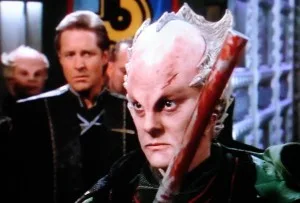
And, most importantly, John Vickery as Neroon carries his key role perfectly. He hates humans, he hates Delenn, and he hates the situation he’s in, but he’s got damned solid reasons for doing so, and for mistrusting the path that Delenn has set the Rangers and Minbari on. He doesn’t trust her as the audience does — and, in so doing, raises some specters of doubt about her in a refreshing way. For all that the early seasons of B5 are about freedom and self-determination, the middle and later seasons are about heroes and the moral obligation to follow them. Delenn and Sheridan are the heroes of the saga, leading the others without question. G’Kar and Londo can be (and are) morally compromised and can be called to task; Sheridan and Delenn cannot. It’s rare that either of them are sincerely challenged as to the righteousness of their cause — Neroon does it to Delenn here (even while Lennier is telling her she needs to be more righteous), and Sheridan will face a major confrontation next season — though it’s always framed as Our Heroes being wronged. So it’s interesting and valuable to see those rare occasions when it does happen, and the figures of myth are, like the Vorlons, questioned.
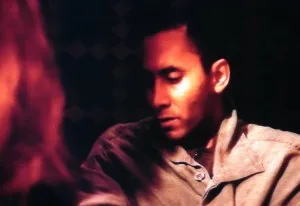
C-Plot: B5 Needs Telepaths! Our Heroes are actively recruiting any teeps they can find for the Shadow War — with the problem that even when they find one, the teeps usually back out once they discover what they are wanted for. (Can you blame them?)
Ivanova tracks down Franklin, who had his Underground Railroad list of escaping telepaths, to see if that will help with the recruitment effort. Conveniently (for the script), stim withdrawal seems to take an inordinately long time to kick in, so Franklin’s feeling pretty sucky right about then. That said, he’s already sick and tired of people tracking him down, and exacts a promise from Ivanova that he will be left alone, no matter what. She agrees, because, of course, you always make promises to drug addicts in withdrawal who are hanging out in the equivalent of Skid Row that you’ll just leave them there until they work things out.
The excuse for the stim withdrawal feels authorially convenient, but at least it’s addressed. That B5 is going after telepaths is useful information, though here it’s played mostly for yocks and to drive a scene with Franklin to set him up for bigger problems down the line. Meh.
Overall: The A-Plot sucks. The B-Plot is pretty darned good. The C-Plot is mediocre filler.
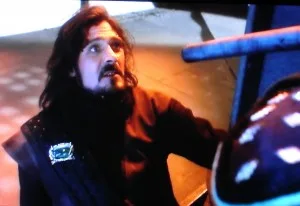
Most Dramatic Moment: Marcus explaining to Neroon why he’s willing to fight to the death — first by creed (“I am a Ranger! We walk in the dark places no others will enter! We stand on the bridge, and no one may pass! We live for the One; we die for the One!”) then, a scosh later, and about to be killed by Neroon:
NEROON: Why? Why all this? Pride? Duty? You’ve been trained well, but you must’ve known you couldn’t win! So why do it?
MARCUS: For her. We live for the One … we die for the One. Isil’zha, sendi … in Valen’s name.
Well played by Carter. (And, by the way, for those going all, “Hey, look, another JMS Lord of the Rings reference,” um, no.)
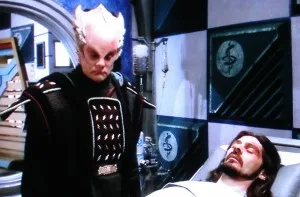
Most Amusing Moment: Marcus rising out of apparent unconsciousness in MedLab to talk with Neroon.
NEROON: Strange that a human in his last moments should be more of a Minbari than I. Perhaps it is true what Delenn said: that we are not of the same blood, but we are of the same heart.
MARCUS: The next time … the next time … you want a revelation … could you possibly find a way … that isn’t quite so uncomfortable …?
Most Arc-ish Moment: Well, I guess Delenn becoming the head of the Rangers.
Overall Rating: 2.5 / 5 — Not the worse episode of B5 ever, but the nadir of Season 3, entirely due to the A-Plot (and not helped much by the C-Plot). (Rating History)
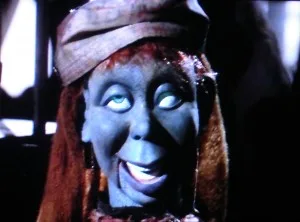
Other Resources for this episode:
- Lurker’s Guide
- Babylon Project Wiki
- IMDb
- AV Club (a good chunk of the “hero” commentary above was inspired by Rowan Kaiser’s observations)
- J Paul Halt
- TV Tropes
- Sci-Fi Musings
Next episode: “And the Rock Cried Out, No Hiding Place,” an episode with a very long name and a very fitting end for a character.
(Google+ links to this post here and here.)

One thought on “B5 Rewatch: 3×19 “Grey 17 Is Missing””